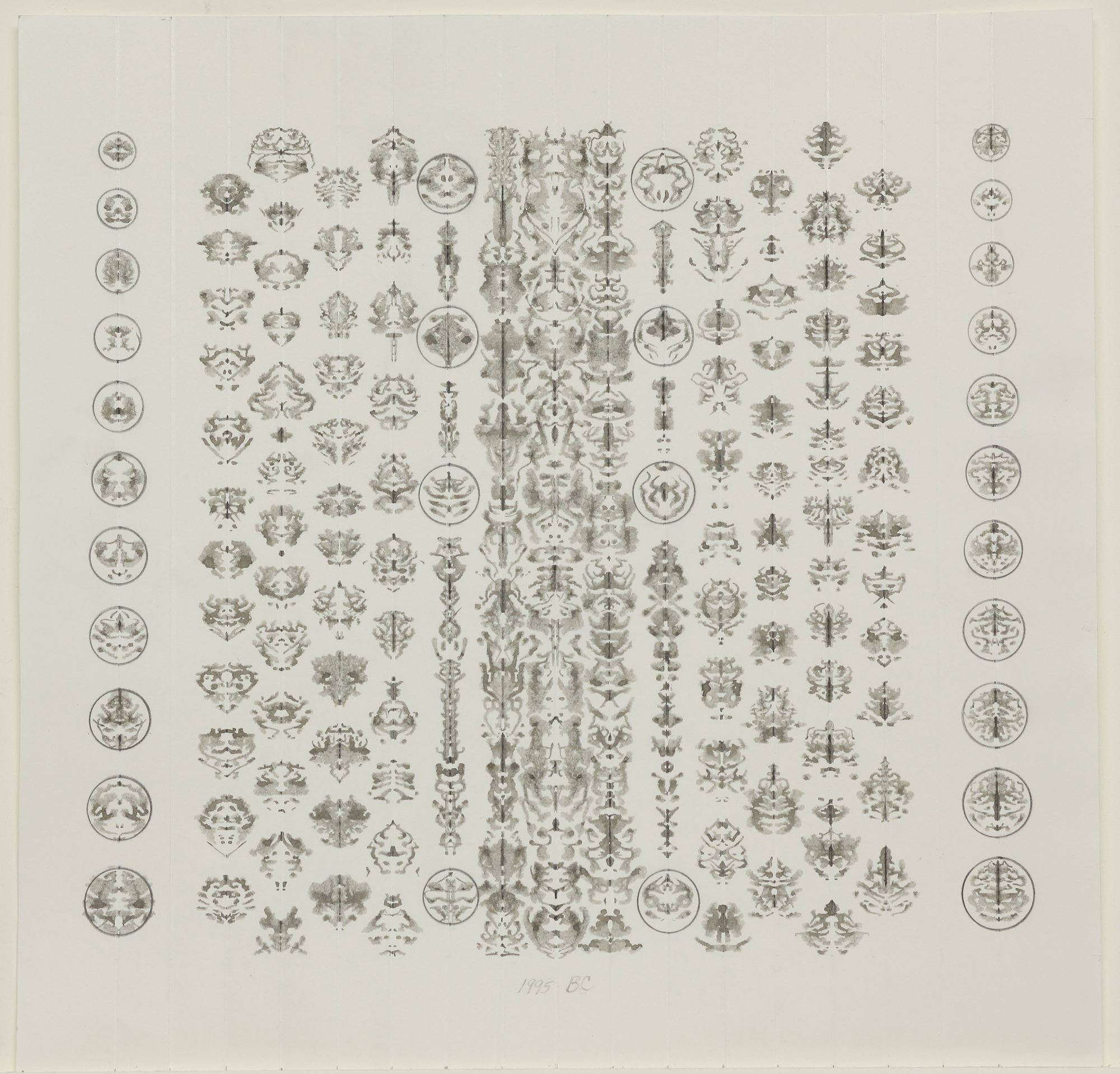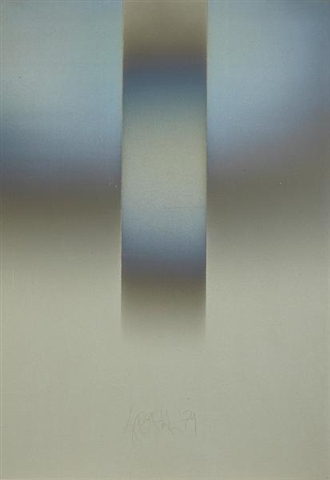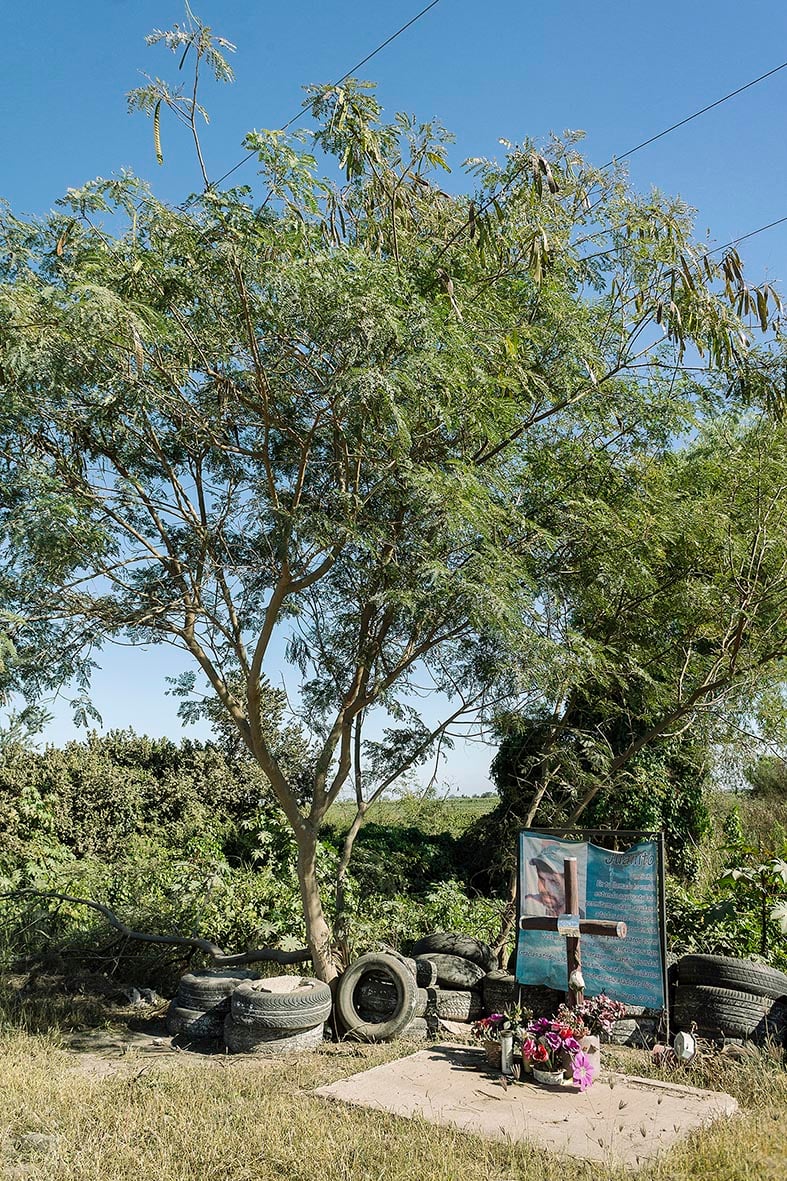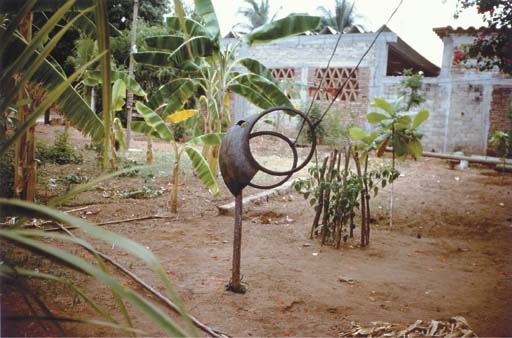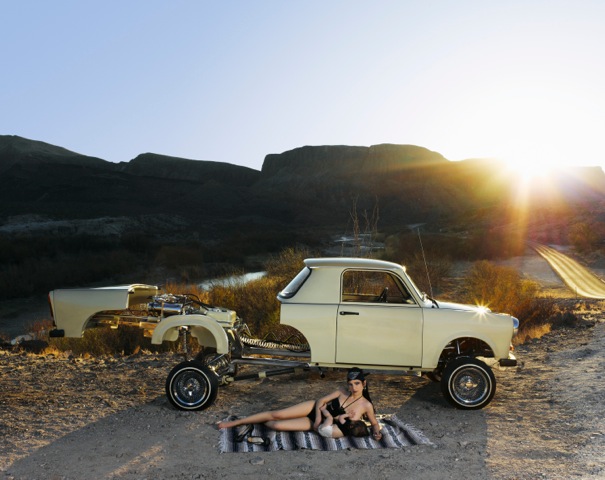
© » KADIST
Miguel Calderon
Tropical Vulture is a cross-generational project which highlights the artistic influences between George Kuchar, a Bay Area legend of independent filmmaking, and Mexican artist Miguel Calderón. Conversations with a Tropical Vulture is an experimental narrative video, co-directed by both artists, and blends Hollywood glamour and drama with an all-too-real life approach, which creates and inspires a counterpoint of unattainable desire against unbearable actuality. The video, shot on location in Acapulco, utilizes a “lo-fi” aesthetic and playful use of non-professional actors.

© » KADIST
Amy Balkin
Data mining is a computer software process that can involve the neutral or benign analyzing of internet data for patterns, however, it can also imply the more sinister activities of surveillance or subject-based information gathering. Amy Balkin’s neon sculpture I (heart) Data Mining , takes on this issue by revealing the acronyms or abbreviations of both technology companies and government bodies that have either profited from data mining, or have used it to political ends. The culprits include Facebook, Investigative Data Warehouse, Apple Computer, The Department of Homeland Security, Narus, Target, and Twitter.

© » KADIST
Francis Alÿs
Drawing & Print (Drawing & Print)
This series of small drawings is executed with varying materials—pen, ink, colored pencil, charcoal, and masking tape—on architect’s tracing paper. Alÿs often executes such sketches in preparation for his performances, videos, and larger two-dimensional bodies of work. As the first visual representations of his ideas, they capture his thinking processes at the raw conceptual stage and allow us to gain a deeper understanding of his larger works.

© » KADIST
Liz Cohen
From among a cloud of fake smoke we see a heavily pregnant Cohen wearing a bikini and golden stilettos with lace-up straps wrapped around her legs, grasping onto the frame of a modified car as its loud hydraulic system clumsily moves it up and down. Pregnant with her first child at the time of the shooting of this video, the car featured in Hydroforce is an aging East German Trabant that the artist transformed into an American El Camino lowrider over the course of a decade, and which features in several of her works. Challenging the politics of the idealized and sexualized female body and the stylized car, Hydroforce establishes a metaphorical connection with her own identity: as a woman, a mother, laborer, and a migrant.

© » KADIST
Mario Garcia Torres
Mario Garcia Torres discovered the work of artist Oscar Neuestern in an article published in ARTnews in 1969. This article, which is the only trace of his work, is indicative of a lack of interest by Neuestern to leave his name in history; to “defend an artistic activity that has little or no interest to last.” Oscar Neuestern could only remember the previous 24 hours, of which his life and his work are in constant erasure and reconstruction. His practice was “to let things be done with time and the unconscious,” while “not fearing the void.” He looked for the absolute through transparency and symmetry.

© » KADIST
Mario Garcia Torres
Mario Garcia Torres films a game of Charades among professional actors guessing the former North Korean dictator’s favorite Hollywood films. Indeed rather surprisingly Kim seems to have had a huge collection of Western videos and he published a book called “On the art of the Cinema” in 1973. As the final acknowledgments indicate, Garcia Torres’s work was produced following in depth research, consulting information given by director Shin Sang-ok who has been kidnapped by Kim in 1978, as well as Jerrold Post (The George Washington University) and Timothy Savage (Nautilus Institute for Security and Sustainable Development).

© » KADIST
Abraham Cruzvillegas
Wright Imperial Hotel (2004) is a sort of bow and arrow made out of feathers, a São Paulo phone book, and other materials. The title is a reference to a building Frank Lloyd Wright designed for Tokyo, which was completed in 1923. In its heyday, which lasted until after World War II, the hotel was reserved for elite personnel, many of them foreigners.

© » KADIST
Carlos Amorales
This work, a large oil painting on canvas, shows a moment from Amorales’s eight-minute two-channel video projection Useless Wonder (2006). The video is based on Edgar Allen Poe’s 1838 novel The Narrative of Arthur Gordon Pym of Nantucket . The painting, derived from an image from a different, preexisting work, represents the artist’s continued interest in realizing particular subject matter in alternative forms, thereby imbuing it with new meanings and interpretations.

© » KADIST
Mario Garcia Torres
Mario Garcia Torres imagines cinematic devices to replay stories occasionally forgotten by Conceptual art. For him, this is a way of rethinking the tradition in a more personal way, to have a grip on events of recent history and examine them with a curiosity, both critical and sensual. The artist emphasizes the fact that new ideas and meanings may arise from these archaeological narratives.

© » KADIST
Carlos Amorales
This work, a large oil painting on canvas, shows a moment from Amorales’s eight-minute two-channel video projection Useless Wonder (2006). The video is based on Edgar Allen Poe’s 1838 novel The Narrative of Arthur Gordon Pym of Nantucket. The painting, derived from an image from a different, preexisting work, represents the artist’s continued interest in realizing particular subject matter in alternative forms, thereby imbuing it with new meanings and interpretations.
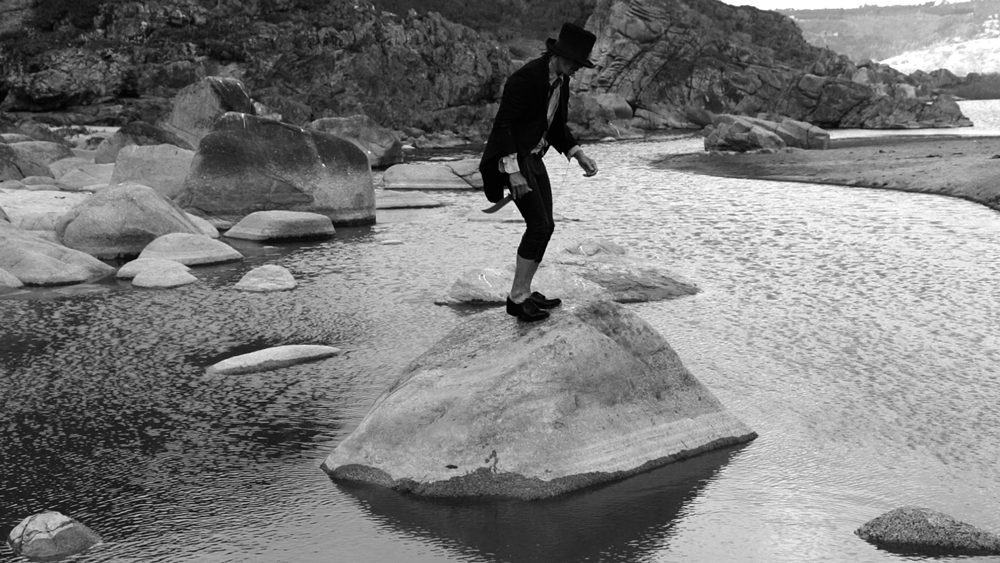
© » KADIST
Carlos Amorales
Carlos Amorales, based in Mexico City, works in many media and combinations thereof, including video, drawing, painting, photography, installation, animation, and performance. Central in his work is the construction and alteration of what he calls his Liquid Archive, a collection of images, narratives, drawings, shapes, and ideas that he uses to construct his unique visual language—a critical and stimulating space for fantasy, reality, and the blurring of the two. Amorales creates tensions between revealing and hiding the personal and the universal in his often-ambiguous and fluid constructions.

© » KADIST
Carlos Amorales
Drawing & Print (Drawing & Print)
Produced on the occasion of an exhibition at ARTIUM of Alava, Basque Centre-Museum of Contemporary Art, this deck of cards is a selection of images from Carlos Amorales’s Liquid Archive. and abstract silhouetted motifs, in a black and white palette, are combined to create a world lodged between fantasy and reality typical of the tarot game. Airplanes, letters, naked women, Osama Bin Laden, Che Guevara, mythological figures, skulls, wrestlers’ masks are some of the visuals that populate this printed object.

© » KADIST
Francis Alÿs
The Nightwatch , which is an ironic reference to the celebrated painting by Rembrandt, follows the course of a fox wandering among the celebrated collections of the National Portrait Gallery in London. The path of the fox, from galleries containing 16th, 17th and 18th century portraits of historic figures from British history hung on plush walls, is circuitous and seemingly random. The fox tracks back and forth, sometimes inspecting the gallery furniture, often walking through the middle of the room but sometimes around its perimeter until eventually it climbs on top of a showcase, covered in fabric where he settles down to sleep.

© » KADIST
Mario Garcia Torres
In Up All Night, Waiting for the Chelsea Hotel Magic to Spark My Creativity Mario García Torres constructs and documents a hypothetical scene, situating himself within a lineage of artists and creatives that used to congregate at the historic hotel. The long-exposure capture depicts García Torres at multiple stages of brainstorming, devising, and introspection, his ethereal figure connected with artistic giants of the past. Yet, there is also an insipid tone beyond mere insomnia or frustration at the lack of being able to garner inspiration.

© » KADIST
Dr. Lakra
Drawing & Print (Drawing & Print)
Like many of Dr. Lakra’s works, Cortes y la malinche is a drawing done on a found vintage magazine page. The text at the bottom of the page, “reclinandose inocentemente sobre el regazo de Hernan-Cortés,” translates to, “reclining innocently in the lap of Hernan Cortés,” and refers to the Spanish conquistador who brought down the Aztec empire. Malinche was a native Mexican who served both as Cortés’s translator in both the Mayan and Aztec languages, as well as his lover.

© » KADIST
Sergio De La Torre
Nuevo Dragon City is a reenactment of a historical event from 1927 in which six Chinese were either trapped or voluntarily hid themselves inside a building in northern Mexico. Working with this unsettled mystery, De La Torre’s video inquires into the historical and continuing tensions between Chinese and Mexicans. As such, Nuevo Dragon City depicts a symbolic act of self-entrapment in which six untrained actors of Chinese descent silently blockade themselves inside in an empty Tijuana storefront.

© » KADIST
Doug Aitken
The version of Frontier acquired by the Kadist Collection consists of a single-channel video, adapted from the monumental installation and performance that Aitken presented in Rome, by the Tiber River, in 2009. In this film, Aiken’s allusion to “the frontier” and iconic imagery like the cowboy suggest that the American West Coast as a cultural construction. These notions are reinforced by two key elements in the film: its protagonist, the iconic West Coast artist Ed Ruscha, and its reference to the cinematic and the experience of the movie theater.

© » KADIST
Sergio De La Torre
This is not in Spanish looks at the ways in which the Chinese population in Mexico navigates the daily marginalization they encounter there. The neon translates as “this is not in Spanish,” making reference to both the famous Rene Magritte painting “Ceci n’est pas une pipe” as well as signs posted in the windows of Chinese establishments in Mexico.

© » KADIST
Pedro Reyes
Pedro Reyes’s Los Mutantes ( Mutants , 2012) is composed of 170 plates that combine characters from ancient and modern mythologies. As in a periodic table, animals and objects are combined with humans (male or female), providing a rational framework for the irrational products of human imagination. A Cartesian matrix such as this must follow certain rules.

© » KADIST
Gabriel Orozco
Gabriel Orozco often documents found situations in the natural or urban landscape. He travels armed with his camera and insightfully captures scenes of the everyday that other people might ignore. Perro en Tlalpan (Dog in Tlalpan, 1992) is a photograph of a dog regally perched under an industrial shelter in the borough of Tlalpan in Mexico City.
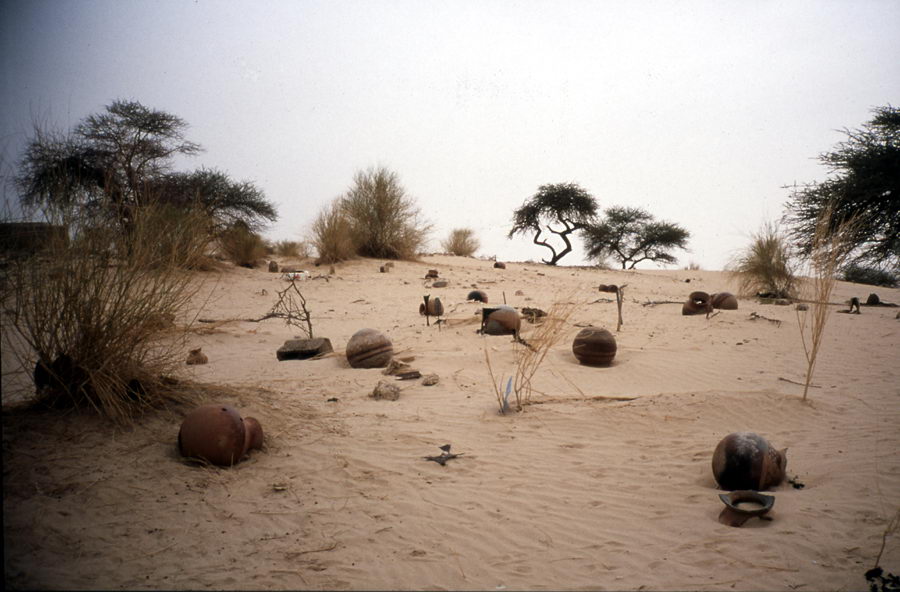
© » KADIST
Gabriel Orozco
Gabriel Orozco comments: “In the exhibition [Documenta 11, Kassel, 2002], I tried to connect with the photographs I took in Mali in July. I traveled to Mali for three weeks and took some photographs related to my work. They are very different, but there are links as the graveyard of Timbuktu, which I discovered during the trip.

© » KADIST
Bruce Conner
Unlike many of his earlier films which often present poignant critiques of mass media and its deleterious effects on American culture, EASTER MORNING , Conner’s final video work before his death in 2008, constitutes a far more meditative filmic essay in which a limited amount of images turn into compelling, almost hypnotic visual experience. The video presents us with a reinterpretation of footage from his unreleased avant-garde film, Easter Morning Raga , from 1966. In contrast to his more famous pieces like A Movie (1958) and Crossroads (1976) which are juxtapositions of fragments from newsreels, soft-core pornography, and B movies, the images in EASTER MORNING serve as a reinterpretation of footage.

© » KADIST
John Baldessari
Drawing & Print (Drawing & Print)
The voids in Baldessari’s painted photographs are simultaneously positive and negative spaces, both additive and subtractive. In Person with Pillow: Desire, Lust, Fate , a woman’s facial expression is obscured by such void, leaving only her posture to suggest her emotional state. The two images stacked above the woman can be read as comic-style thought bubbles, intimating that she has lust, desire, and fate on her mind.

© » KADIST
Larry Bell
Untitled (Construction) recalls the series of glass cubes that gained Bell international recognition in the 1960s. Resembling a black-mirrored box, this recent iridescent piece produces an uncanny effect in which the interior planes seem to enclose a mysterious light. Although austere in form, Bell’s works are far from simple: he uses technology like a vacuum-coating process, to accurately control the different levels of opacity and transparency on the surface of his immaculate glass works.
Mario Garcia Torres
- location: Mexico City, Mexico
- year born: 1975
- gender: male
- nationality: Mexican
- home town: Monclova, Mexico
Carlos Amorales
- year born: 1970
- gender: male
- nationality: Mexican
- home town: Mexico City, Mexico
Pedro Reyes
- location: Mexico City, Mexico
- year born: 1972
- gender: male
- nationality: Mexican
- home town: Mexico City, Mexico
Gabriel Orozco
- location: New York City, Paris
- location: Mexico
- year born: 1962
- gender: male
- nationality: Mexican
- home town: Jalapa, Mexico
Bruce Conner
- location: San Francisco, California
- year born: 1933
- gender: male
- nationality: American
- home town: McPherson, Kansas
John Baldessari
- location: Los Angeles, California
- year born: 1931
- gender: male
- nationality: American
- home town: National City, California
Sergio De La Torre
Sergio De La Torre has worked with and documented the manifold ways in which citizens reinvent themselves in the city they inhabit, as well as the site-specific strategies they deploy to move “in and out modernity.” De La Torre often collaborates with his subjects, resulting in both intimate and critical reflections on topics like housing, immigration, and labor...
Liz Cohen
Liz Cohen is a photographer and performance artist best known for her project Bodywork , in which she transformed a German car into a lowrider while simultaneously transforming her own body, with the help of a fitness instructor, to become a bikini model at lowrider shows...
Abraham Cruzvillegas
- location: Mexico
- year born: 1968
- gender: male
- nationality: Mexican
- home town: Mexico City, Mexico
Larry Bell
- location: Venice, California
- year born: 1939
- gender: male
- nationality: American
- home town: Chicago, Illinois
Minerva Cuevas
- location: Mexico City, Mexico
- year born: 1975
- gender: female
- nationality: Mexican
- home town: Mexico City, Mexico
Julieta Aranda
- location: Mexico City, Mexico
- year born: 1975
- gender: female
- nationality: Mexican
- home town: Mexico City, Mexico
Edgar Arceneaux
- location: Los Angeles, California
- year born: 1972
- gender: male
- nationality: American
- home town: Los Angeles, California
Kadar Brock
Kadar Brock makes large-scale abstract paintings via a rigorous process of layering, erasing, and reworking his surfaces; his highly textured canvases are variously discordant, exuberant, and topographical in nature...
Teresa Margolles
Teresa Margolles’s work examines the social causes and consequences of violence...
Dr. Lakra
- location: Oaxaca, Mexico
- year born: 1972
- gender: male
- nationality: Mexican
Miguel Calderon
Miguel Calderón is a Mexican artist and writer...
Amy Balkin
Based in San Francisco, Amy Balkin’s various long-term projects respond to society’s relationship to the land, the atmosphere, the ocean and other natural resources, and how these resources have been used and valued...
Doug Aitken
- year born: 1968
- gender: male
- nationality: American
- home town: Redondo Beach, California
-
1970-1979
Bruce Conner
1978In 1977, as an already-established artist best known for his films, Bruce Conner began to photograph punk rock shows at Mabuhay Gardens, a San Francisco club and music venue...
Larry Bell
Drawing & Print
1979(Drawing & Print) Like many of Larry Bell’s works, VFGY9 deals primarily with the viewer’s experience of sight...
-
1990-1999
John Baldessari
Drawing & Print
1991(Drawing & Print) The voids in Baldessari’s painted photographs are simultaneously positive and negative spaces, both additive and subtractive...
Gabriel Orozco
1992Gabriel Orozco often documents found situations in the natural or urban landscape...
Gabriel Orozco
1994Charco portátil congelado (Frozen Portable Puddle, 1994) is a photographic record of an installation of the same name that Gabriel Orozco made at Witte de With Center for Contemporary Art in Rotterdam for the group exhibition WATT (1994)...
Bruce Conner
Drawing & Print
1995(Drawing & Print) Bruce Conner is best known for his experimental films, but throughout his career he also worked with pen, ink, and paper to create drawings ranging from psychedelic patterns to repetitious inkblot compositions...
John Baldessari
1997In One Must , an image of a pair of scissors, accompanied by the words of work’s title, poses an ominous question about the relationship between the image and the text...
-
2000-2009
Gabriel Orozco
2002Gabriel Orozco comments: “In the exhibition [Documenta 11, Kassel, 2002], I tried to connect with the photographs I took in Mali in July...
Francis Alÿs
2004The Nightwatch , which is an ironic reference to the celebrated painting by Rembrandt, follows the course of a fox wandering among the celebrated collections of the National Portrait Gallery in London...
Abraham Cruzvillegas
2004Wright Imperial Hotel (2004) is a sort of bow and arrow made out of feathers, a São Paulo phone book, and other materials...
Mario Garcia Torres
2004Mario Garcia Torres imagines cinematic devices to replay stories occasionally forgotten by Conceptual art...
Carlos Amorales
Drawing & Print
2005(Drawing & Print) Produced on the occasion of an exhibition at ARTIUM of Alava, Basque Centre-Museum of Contemporary Art, this deck of cards is a selection of images from Carlos Amorales’s Liquid Archive...
Mario Garcia Torres
2005Mario Garcia Torres films a game of Charades among professional actors guessing the former North Korean dictator’s favorite Hollywood films...
Pedro Reyes
2005In Reyes’s words, “We should be able to extract the technological nutrients before we excrete our waste...
Francis Alÿs
Drawing & Print
2006(Drawing & Print) This series of small drawings is executed with varying materials—pen, ink, colored pencil, charcoal, and masking tape—on architect’s tracing paper...
Carlos Amorales
2006This work, a large oil painting on canvas, shows a moment from Amorales’s eight-minute two-channel video projection Useless Wonder (2006)...
Edgar Arceneaux
Drawing & Print
2006(Drawing & Print) Untitled (Wheelchair Drawing) is a ten-foot photo transfer of the image of a wheelchair with burning embers in its seat...
Minerva Cuevas
Drawing & Print
2006(Drawing & Print) During her research on primitive currencies and cultural cannibalism, Cuevas came across the Donald Duck comic book issue “The Stone Money Mystery,” where Donald goes on a quest to find missing museum objects...
Carlos Amorales
2007This work, a large oil painting on canvas, shows a moment from Amorales’s eight-minute two-channel video projection Useless Wonder (2006)...
Larry Bell
2007Untitled (Construction) recalls the series of glass cubes that gained Bell international recognition in the 1960s...
Kadar Brock
2007Kadar Brock creates dynamic abstract paintings that are born from a process of painting, scraping, priming, sanding, and painting again...
Bruce Conner
2008Unlike many of his earlier films which often present poignant critiques of mass media and its deleterious effects on American culture, EASTER MORNING , Conner’s final video work before his death in 2008, constitutes a far more meditative filmic essay in which a limited amount of images turn into compelling, almost hypnotic visual experience...
Sergio De La Torre
2008Nuevo Dragon City is a reenactment of a historical event from 1927 in which six Chinese were either trapped or voluntarily hid themselves inside a building in northern Mexico...
Doug Aitken
2009The version of Frontier acquired by the Kadist Collection consists of a single-channel video, adapted from the monumental installation and performance that Aitken presented in Rome, by the Tiber River, in 2009...
Miguel Calderon
2009Tropical Vulture is a cross-generational project which highlights the artistic influences between George Kuchar, a Bay Area legend of independent filmmaking, and Mexican artist Miguel Calderón...
-
2010-2019
Mario Garcia Torres
2010In Up All Night, Waiting for the Chelsea Hotel Magic to Spark My Creativity Mario García Torres constructs and documents a hypothetical scene, situating himself within a lineage of artists and creatives that used to congregate at the historic hotel...
Sergio De La Torre
2011This is not in Spanish looks at the ways in which the Chinese population in Mexico navigates the daily marginalization they encounter there...
Pedro Reyes
2012Pedro Reyes’s Los Mutantes ( Mutants , 2012) is composed of 170 plates that combine characters from ancient and modern mythologies...
Amy Balkin
2012Data mining is a computer software process that can involve the neutral or benign analyzing of internet data for patterns, however, it can also imply the more sinister activities of surveillance or subject-based information gathering...
Carlos Amorales
2014Carlos Amorales, based in Mexico City, works in many media and combinations thereof, including video, drawing, painting, photography, installation, animation, and performance...
Teresa Margolles
2014Stretching between San Pedro and the beach in Altata, Sinaloa, there is a 40 km road where there are three invisible borders controlled by rivalling armed groups...
Julieta Aranda
2016The video Swimming in rivers of Glue is composed of various images of nature, exploring the themes of exploration of space and its colonization...








